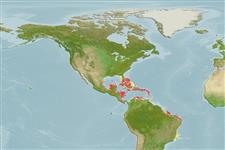Teleostei (teleosts) >
Gobiiformes (Gobies) >
Gobiidae (Gobies) > Gobiinae
Etymology: Bathygobius: Greek, bathys = deep + Latin, gobius = gudgeon (Ref. 45335); antilliensis: Name formed from the proper noun 'Antilles', in reference to the islands of the Antilles, which constitute most of the known range of this species and where it is most abundant..
Environment: milieu / climate zone / depth range / distribution range
Ecology
Marine; benthopelagic. Tropical
Western Atlantic: insular and continental islands in the Caribbean.
Size / Weight / Age
Maturity: Lm ? range ? - ? cm
Max length : 9.4 cm SL male/unsexed; (Ref. 85559)
Short description
Identification keys | Morphology | Morphometrics
Dorsal spines (total): 7; Dorsal soft rays (total): 9; Anal spines: 1; Anal soft rays: 8. This species is distinguished by the following characters: 18-21 pectoral fin rays; 38-42 lateral scale rows; upper jaw length 9.5-13 % SL, rarely less than 11% SL; predorsal squamation reaching anteriorly beyond vertical through posterior margin of preopercle, often reaching posterior edge of postorbital blotch; first dorsal fin with 1-4 dark blotches on each element forming 1-4 stripes across fin or with one broad, dark brown longitudinal stripe across middle of fin; ventral portion of trunk with 2 rows of markings, upper row with 7-8 dark blotches along lateral midline from beneath pectoral fin to point just anterior to markings on caudal peduncle, lower row typically consisting of 3 conspicuous dark spots - occasionally with diffuse 4th spot beginning beneath ventral portion of pectoral fin and terminating just anterior to origin of anal fin (Ref. 85559).
Collected primarily from reef crests and from shallow tidepools on exposed beaches, where it typically co-occurs with B. mystacium and B. lacertus. A single specimen was collected from a sheltered rocky shoreline near an irrigation canal in Puerto Rico and associated with three species, B. geminatus, B. lacertus, and B. soporator. GenBank accession number for COI sequence of holotype: HM748393 (Ref. 85559).
Life cycle and mating behavior
Maturities | Reproduction | Spawnings | Egg(s) | Fecundities | Larvae
Tornabene, L., C. Baldwin, L.A. Weigt and F. Pezold, 2010. Exploring the diversity of western Atlantic Bathygobius (Teleostei: Gobiidae) with cytochrome c oxidase-I, with descriptions of two new species. aqua, Int. J. Ichthyol. 16(4):141-170. (Ref. 85559)
IUCN Red List Status (Ref. 130435)
Threat to humans
Harmless
Human uses
Tools
Special reports
Download XML
Internet sources
Estimates based on models
Preferred temperature (Ref.
123201): 26.7 - 28.2, mean 27.5 °C (based on 541 cells).
Phylogenetic diversity index (Ref.
82804): PD
50 = 0.5000 [Uniqueness, from 0.5 = low to 2.0 = high].
Bayesian length-weight: a=0.00708 (0.00333 - 0.01504), b=3.09 (2.92 - 3.26), in cm total length, based on LWR estimates for this (Sub)family-body shape (Ref.
93245).
Trophic level (Ref.
69278): 3.5 ±0.5 se; based on size and trophs of closest relatives
Fishing Vulnerability (Ref.
59153): Low vulnerability (10 of 100).
